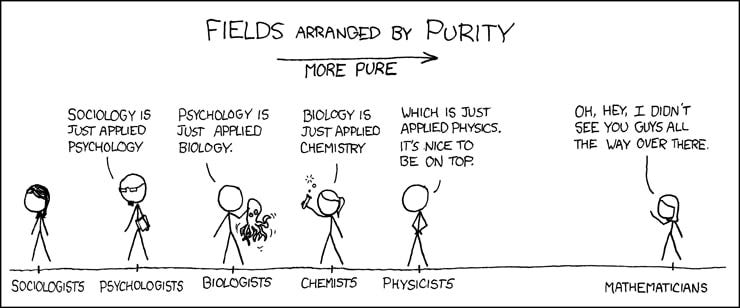The Intriguing Connection Between Math and the Universe
Written on
Chapter 1: Understanding the Quote
Recently, I stumbled upon an intriguing statement online:
“Applied Math is Physics; Applied Physics is Chemistry; Applied Chemistry is Biology; Applied Biology is Psychology; Applied Psychology is Sociology.”
My initial response was one of admiration. It seemed that this perspective held a degree of truth. However, like many insights we encounter, I filed it away in my mind without further examination.
But not long ago, I revisited this quote and felt compelled to delve deeper.
To truly grasp this statement, we must trace our thoughts back to the very origin of the Universe. The entirety of our existence—everything we know—emerged from Matter and Energy. These fundamental elements birthed Atoms, which in turn formed Molecules. Some of these molecules evolved into complex life-sustaining structures, such as proteins, DNA, and RNA, eventually leading to the emergence of life. And here we are, composed of these life-sustaining molecules, atoms, matter, and energy—thanks to this intricate progression.
Now, let’s take a broad view of these various fields of study. The exploration of matter, energy, and their interactions is classified as Physics. Following this, Chemistry focuses on atoms, molecules, and their interactions. This is succeeded by Biology, which examines organic molecules and their interactions, leading to the study of living organisms. Psychology follows as it investigates the thought processes of these beings, while Sociology looks at the collective behavior of these organisms within groups.
Thus, it's evident that we are leveraging our understanding from one discipline to enhance our study of another, much like applying knowledge about matter and energy to decode the behavior of atoms and molecules. This forms a hierarchical structure, akin to a pyramid.
It’s essential to clarify that the goal here is not to elevate one field above another but rather to recognize the interconnectedness of various branches of study and how humanity has constructed knowledge incrementally.
With that in mind, let’s address the most critical aspect that I initially set aside: the equation Applied Math = Physics.
I reserved this topic for last because it required a more profound contemplation. Concepts like Matter and Energy, or Atoms and Molecules are tangible entities that we can observe in reality. In contrast, Math is an abstract notion. Therefore, comprehending how Math integrates into this framework—especially as a foundational element—can be challenging.
To simplify, let’s consider what we mean by Physics. In our earlier example concerning Matter and Energy, Physics pertains to the study of the underlying principles and hidden patterns that govern these entities (such as E = mc²).
What are these principles? Are they tangible entities? Not quite. They are essentially numerical representations. These rules and numbers arise through the application of Math.
Importantly, the patterns exist independently in the Universe; we do not create these rules (the essence of Physics) and then expect the patterns to manifest. Instead, we uncover these patterns through mathematical exploration.
Thus, it stands to reason that Applied Math = Physics.
Before I conclude, let's ponder where Math originates. Similar to the patterns of the Universe waiting to be discovered, Math is also an inherent part of existence—vast and infinite—awaiting our exploration. The portions we have uncovered help us interpret our world better by revealing the hidden laws and patterns. In essence, the Universe communicates through Math, reinforcing the idea that Math is indeed the language of the Universe.

Chapter 2: Exploring Mathematical Patterns
Here we will dive into the relationship between math and our understanding of the Universe through illustrative content.
The first video, Is Math the Language of the Universe?, discusses the pivotal role that mathematics plays in understanding the fundamental laws of nature.
The second video, Is Maths the Language of the Universe? (Duocon 2022), provides insights from experts on how mathematics shapes our comprehension of the cosmos.